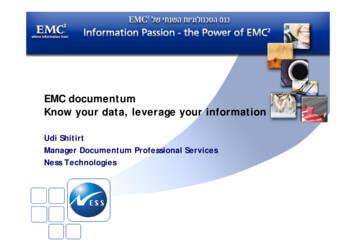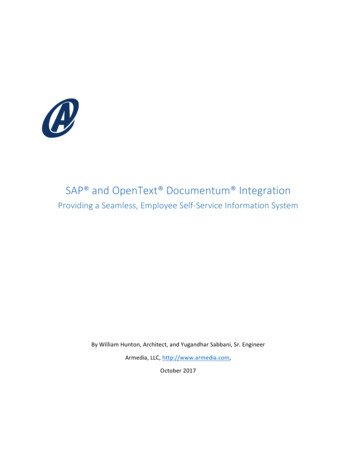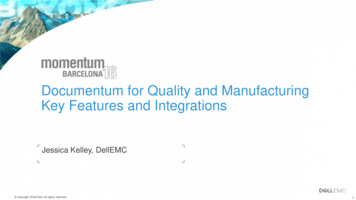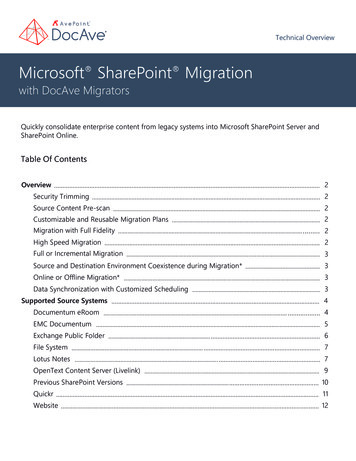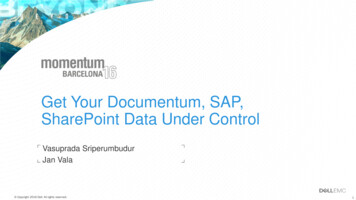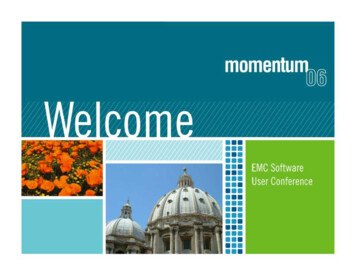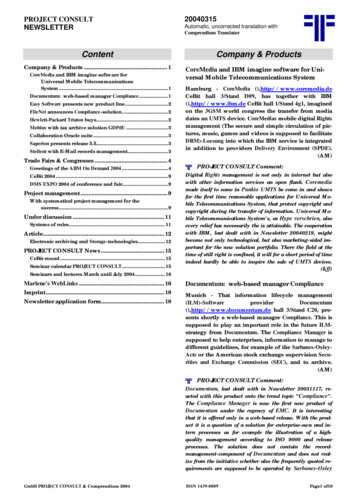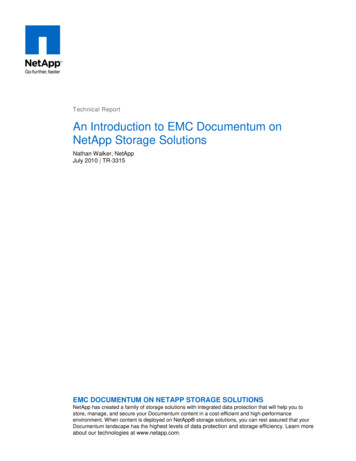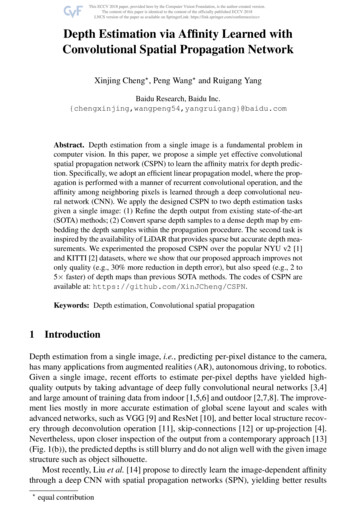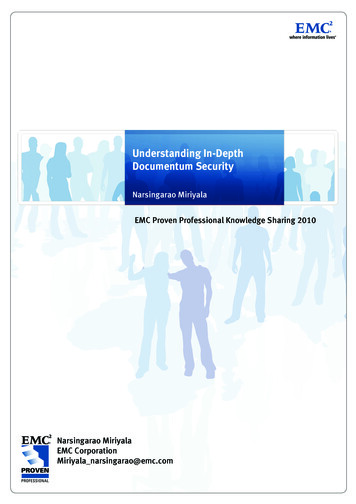
Transcription
Understanding In-DepthDocumentum SecurityNarsingarao MiriyalaEMC Proven Professional Knowledge Sharing 2010Narsingarao MiriyalaEMC CorporationMiriyala narsingarao@emc.com
ContentsBackground . 4Background . 4Introduction . 4Audience . 5Terminology . 5Documentum Repository Security . 6Identity Management . 6In‐Line Users . 6LDAP Users . 6Local OS Users . 7Windows Domain Users . 7Authentication . 7Authorization . 8Trusted Content Services (TCS) . 9Content Encryption . 9Digital Shredding of Content . 11Auditing . 12Single Sign on (SSO) . 13Secure Communication . 15Documentum Content Read Transaction . 18SSL Offloading . 21Proxy ACS requests . 21Approved DFC Clients. 23Documentum Administration Concerns . 23Content Server Installation Owner Password Rotation . 25Information Rights Management (IRM). 25
Table of FiguresFigure 1 (Documentum Encryption) . 11Figure 2 (Documentum SSO) . 15Figure 3 (Documentum Repository) . 17Figure 4 (Documentum Secure Transactions) . 19Figure 5 (Documentum Secured Content Communication) . 20Figure 6 (Offloading SSL) . 22Disclaimer: The views, processes or methodologies published in this compilation are those of the authors. They do notnecessarily reflect EMC Corporation’s views, processes, or methodologies2010 EMC Proven Professional Knowledge Sharing3
BackgroundI have designed Enterprise Content Management Systems (ECMS) and led contentstrategy for corporations of all sizes. Business and IT stake holders of ECM projectsoften ask system architects to achieve security accreditation from the Office ofInformation Security (OIS) in addition to certifying the system design and solution by theCorporate Architecture Review Board. Fulfilling these two requests is not trivial.Currently, there are tools and documentation available within our organization to presenta well defined and detailed system design to the Architecture Review Board.But when it comes to presenting the system design for OIS accreditation, it is dauntingdue to the lack of proper procedures, tools and documentation. Security accreditation ofa system design would not be so challenging if we could list all of the security relatedinformation in a prescribed document. This is my effort to develop such a document forOIS accreditation for all Documentum applications and solutions.IntroductionA Documentum repository can contain a corporation’s most sensitive assets such asFinancial, HR, Product roadmaps, Product patents or Service offerings data /documentation. Every company’s OIS team guards their repository assets fromunauthorized access by users or system administrators. Corporations want to protecttheir vital data during transmission as well as when in storage. This article will not coverDocumentum basic security like ACLs, groups, roles etc. as all of these topics areextensively covered in Content server documentation. I am going to cover the topicsthat are difficult to find in the documentation. This article is written from a Documentum6.5 release perspective.2010 EMC Proven Professional Knowledge Sharing4
AudienceThis article is written for customers, partners and consultants validating Documentuminfrastructure for Security certification. It can be used by technical team as referencematerial to build the Documentum infrastructure to meet business requirements. It isassumed that the audience is familiar with the Documentum repository.TerminologyACL – Access Control List, ACL’s are applied on object levelACS – Accelerated Content Services, ACS server is used to read/write content files fromuser browser to storage. ACS is part of Content Server embedded JBoss applicationserver.DFC – Documentum Foundation Client, All WDK or Custom clients use DFC to connectto Repository.OIS – Office of Information SecurityTCS – Trusted Content ServicesUCF – Unified Client Framework, UCF is deployed on Client Machine as Java Applet.UCF communicates with Application Server and ACS server for all Content relatedoperations like import/export/check-in/check-out.WDK – Web Development Kit, it is a framework. WebTop, DAMTop, DocumentumAdministrator (DA) are developed using WDK.WebTop – Documentum Web Client developed using WDK frameworkDA – Documentum Administrator, DA is used by Documentum admin person toadminister the repository.2010 EMC Proven Professional Knowledge Sharing5
Documentum Repository SecurityDocumentum Repository Security is categorized as the following” Identity ManagementAuthenticationAuthorizationTrusted Content Services (TCS)AuditingIdentity ManagementDocumentum repository can have the following set of users: In-Line usersLDAP usersLocal OS usersWindows Domain usersIn-Line UsersDocumentum Administrators create Inline users, encrypt their passwords, and storethem in the repository. This is an easy way to create users in the repository, although itis less secure than other options.LDAP UsersYou can configure the Documentum Repository to integrate with Corporate DirectoryServices to synchronize users and groups. Documentum supports all the major LDAPdirectory services. The Repository supports synchronizing users and groups frommultiple directory servers. The system can be configured to secure the transmission(SSL) between the repository and LDAP server. The system allows synchronizingmultiple user and group object attributes from the LDAP server and stored in Repositoryas dm user/dm group or a subtype of dm user/dm group objects. User passwords arenot retrieved from the LDAP server. The Repository will connect to LDAP server for userauthentication.The Synchronization job also updates/disables users in the repository if a user isdisabled in the LDAP server or if user attributes are updated (like last name) in LDAP.2010 EMC Proven Professional Knowledge Sharing6
Local OS UsersDocumentum can be configured to authenticate users on the host OS; administratorscreate user objects in the repository corresponding to local users on underline OS for theContent Server. The Repository will authenticate the user with the underlying OS.Windows Domain UsersYou can configure a Repository running on Windows OS to authenticate users with theWindows domain. The Administrator has to create domain users manually in therepository before users can login to Documentum.AuthenticationAs I explained in the previous section, Documentum will not store the user password inthe repository (except for in-line users). The user must provide userid, password, anddomain name (optional). The repository takes the information provided by the user andauthenticates it with the corresponding authentication mechanism based on the userinfo. If the user is from an LDAP server, the repository will authenticate the user with theLDAP server. If the user is created as a Windows domain user, the repository willauthenticate the user with the Windows domain, similarly for OS users.Documentum also has built in additional mechanisms for authorized access to thesystem such as: Session Timeout – System will timeout a user session and release all theresources held by user if the user is inactive for a period of time. The Inactiveperiod can be configurable. The System can be configured to lock the user if he/she enters the wrongpassword for a pre-defined number of times. This functionality also addressesthe Brute Force Attacks issues. The System can be configured to record audit events when a user logs into thesystem. The System captures the date and the time when the user logged intothe system. It can also capture unsuccessful logins as part of audit.2010 EMC Proven Professional Knowledge Sharing7
AuthorizationThe Documentum Repository allows users to access assets at an object level using theAccess Control List (ACL). ACLs can grant access privileges explicitly to users, groups,or roles.The Repository provides the following basic level of permissions: None – Objects with users having “None” permission cannot see the objects insearch results or through folder navigation. If you don’t want a user or group toview your assets, give “None” permission to that group or individual user in ACL. Browse – This permission allows users to view the metadata but not the content.User can search for this document, the system will show the document metadatain search results, but users cannot open the content. Read – This permission allows users to read/view the metadata and content ofthe asset. Relate – This permission allows user to read/view metadata and content and italso allows users to create relations. This is useful when a user is trying to createannotations on the assets. Version – This permission allows users to create new versions of the asset. Thesystem will not allow the user to save an updated document as the same version.The User also gets Read and Relate permission. Write – This permission allows the user to create new documents and updatethe old document. The System allows users to save the updated old documentas the same or a new version. The User also gets Read, Relate, and Versionpermissions. Delete – The User has right to Delete the assets along with Write, Version,Relate, and Read permissions DELTE OBJECT – This is an additional permission granting users the ability todelete the asset. It will take away other permissions that are allowed in regulardelete as described in the above bullet.Each of the above permissions is hierarchical. For example, if the user has writepermission on a file then he/she also has version, relate, read, and browse permissions.2010 EMC Proven Professional Knowledge Sharing8
The Repository also provides extended permission sets which are also part of ACLs.These permissions are not hierarchical. Change Location – Allows user to move objects from one folder to another Change Ownership – User can change the owner of the object Change Permission – User can change the basic permission on the object Change State – User can change the document lifecycle state Execute Procedure - User is allowed to execute an external procedureassociated with object Change Folder Link – User allowed to Link an object to a folder or Unlink a objectfrom a folderTrusted Content Services (TCS)TCS is an add-on service that requires a license. It allows the following additionalfunctionality in the repository: Content encryption Digital Shredding of Content Multi Dimensional Access Controls (MDAC) Digital SignatureI will address the first two topics in this article. Please refer to the Documentum ContentServer Administration guide for complete details on the remaining two topics.Content EncryptionIf you create an encrypted file store in the repository, all the content saved to this filestore is encrypted before writing to disk. When a user reads this content, the repositorydecrypts the file in the content server before forwarding the file/document to user. Thisfeature protects the data stored on the disk so that the system administrator or a storageadministrator cannot read the content from the operating system. There will be a 5 to10% performance hit depending on the file size when you encrypt the content.Applications can be designed to store only highly sensitive documents in encrypted filestore and the balance of documents in non-encrypted (regular) file stores. You can also2010 EMC Proven Professional Knowledge Sharing9
have multiple encrypted file stores and configure an application to segregate the contentbased on the document type.Content in an encrypted file store is encrypted using a symmetric key (called FEK or FileEncryption Key). This key is unique for every content object. The FEK is encrypted usinganother key called FSK (or File Store Key). This key is different for every file store. It isstored in the “dm filestore” object associated with the encrypted file store. The FSK isencrypted using a DBK (or Docbase Key), and the DBK itself is encrypted using the AEK(or Application Encryption Key). The DBK is unique for every repository; it is stored indocbase config object “dm docabase config” The AEK is the master key for the system.AEK key is stored on the Content Server Installation location( DOCUMENTUM/dba/secure) as shown in Figure 1 (Documentum Encryption). All keylengths are 192 bits and 3DES-EDE-CBC is the algorithm employed for each encryption.The DBK and FSK are Base64 encoded after encryption and stored in the database.The encrypted FEK is stored along with the content as part of the object properties. TheAEK is encrypted using a passphrase using PKCS #5 standards. This is the passphraseyou need to enter when the Content Server is being started. The algorithm used for AEKencryption is 3DES-EDE-CBC. The iteration count is 1024, and the salt size is 8 bytes.The encrypted AEK is stored in a file.During installation, the system creates the AEK key with a default passphrase. Irecommend changing the passphrase before configuring the first repository.I also recommend taking a backup of the AEK key.Content File Stores on storage have full permissions to the Content Server Installationowner. No access is granted on Files Stores at the OS level to any user or group outsidethe Installation Owner.2010 EMC Proven Professional Knowledge Sharing10
Figure 1 (Documentum Encryption)Digital Shredding of ContentWhen a user deletes a document from a repository, the system deletes the sysobject butleaves the content file on storage/disk. This is called orphan content. Documentum has autility called dmfilescan that generates a script with a list of all the orphan files on thedisk for all the file stores. The Documentum administrator must run the generated scriptto remove the orphan content from the file system. There is a time gap from the deletionof an object in the repository to the deletion of a physical file on the disk.Digital Shredding can be turned on at the file store level. When this option is on, thesystem will delete the content on disk at the same time as the user deletes the documentin the repository. This is done in a single transaction. This option is frequently used incompliance environments.2010 EMC Proven Professional Knowledge Sharing11
Digital shredding provides a final, complete way to remove content from a storage areaby ensuring that deleted content files may not be recovered by any means. The systemautomatically writes over the location data multiple times to ensure that the file cannot berecovered by disk utilities or other security software.AuditingAuditing is the process of recording the occurrence of system and application events inthe Repository . Events are operations performed on objects in a Repository orsomething that happens in an application. System events are events that the ContentServer recognizes and can audit. Application events are user-defined events. They arenot recognized by the Content Server and must be audited by an application. By default,the Content Server always audits the following system events:1. All executions of an Audit or Unaudit method2. User login failure3. All executions of a Signoff, Adddigsignature, or Addesignature method4. You can also audit many other operations. For example, you can audit: All occurrences of an event on a particular object or object type All occurrences of a particular event, regardless of the object to which itoccurs All workflow-related events All occurrences of a particular workflow event for all workflows startedfrom a given process definition All executions of a particular jobPlease refer to Content Server Administration guide for complete list of audit events.2010 EMC Proven Professional Knowledge Sharing12
Single Sign on (SSO)Documentum, out of the box, supports Single Sign On with Netegrity SiteMinder andRSA Access Manager. Let’s look at more detail of the SiteMinder solution.Netegrity SiteMinder offers SSO functionality across single and multiple domains,simplifying the use of applications across various Web and application servers andacross multiple operating systems. It also provides policy-based, centralized control ofuser authentication and access management. The SiteMinder Web agent is installed onthe WebTop application Server. This agent will check all traffic to the application serverfor SiteMinder trusted user session cookie as part of the header. If the agent detects anun-trusted session or no SiteMinder cookie in the header, it will forward the user to theSiteMinder server for authentication before continuing to process the user request.The Netegrity configuration performs the following operations: Netegrity invokes an authentication page when the user accesses DocumentumWebTop through the proxy after the Netegrity setup. The user can then select a repository and log in to Documentum WebTop withoutproviding login credentials.Execute the following steps when a user tries to access the WebTop application (whichis SiteMinder protected as shown in Figure 2 (Documentum SSO)). If the SiteMinder isconfigured for certificate based authentication, it will automatically validate usercredentials using the certificate from the users desktop. If you configure SiteMinder forform based authentication, the user is prompted with a login screen to enter userid andpassword for SiteMinder.1. User invokes WebTop URL from browser2. The SiteMinder web agent intercepts the request and redirects the user to theSiteMinder Policy Server to get authenticated3. The User browser connects to the SiteMinder Web server to get authenticated4. Based on the authentication mechanism (form based or certificated based), theuser gets authenticated with the SiteMinder Policy Server. The Policy servergenerates a ticket and stores it in the SiteMinder cookie.2010 EMC Proven Professional Knowledge Sharing13
5. The SiteMinder web server redirects the browser to the WebTop application tocontinue with the user request. The User browser session has SiteMinder cookiewith valid ticket6. The User browser resends the request back to WebTop with the SiteMindercookie7. The SiteMinder web agent checks the cookie and validates the ticket with theSite Minder policy server. Once the web agent confirms the validity of the ticket,the request is passed to the WebTop application.8. The WebTop application is configured to extract the SiteMinder cookieinformation and automatically passes it to the Content Server for authentication.9. The Content Server takes the SiteMinder ticket from the WebTop request andvalidates it with the Policy server.10. If the ticket is valid, the Content Server creates a user session and returns toWebTop.11. WebTop returns the request to the user with a valid user session created.See illustration on the following page.2010 EMC Proven Professional Knowledge Sharing14
Figure 2 (Documentum SSO)Secure CommunicationYou can configure the Documentum Infrastructure for a secure communication from endto-end as shown in Figure 3 (Documentum Repository). The Content server can beconfigured to listen on a secure port, an unsecured port, or both. Based on yourbusiness requirements, you can turn configure the repository to any of the three options.2010 EMC Proven Professional Knowledge Sharing15
In WDK or custom DFC applications, configure the dfc.properties file to connect to thecontent server with a secure or unsecure port. All client programs try to connect first tothe unsecure port by default, if that port is not available the client will try to connect to asecure port.If you have turned on SSL / HTTPS between user the browser and application server,deploy a certificate generated by a trusted CA vendor so that Java on the users’desktops has a trusted CA authority in the local keystore. If you are using a privateinternal certificate, make sure you deploy the CA on users’ java keystore.The Content Server uses the following SSL specifications to communicate with DFC(WDK) clients on a secure port.yADH (Anonymous Diffie-Hellman) for key exchangeykey size: 1024 bitsyAES for data encryption; key length: 256 bitsyHashing algorithm: SHA-1 (Secure Hashing Algorithm)See illustration on the following page.2010 EMC Proven Professional Knowledge Sharing16
Figure 3 (Documentum Repository)2010 EMC Proven Professional Knowledge Sharing17
Documentum Content Read TransactionLet’s look into Documentum Read/View Transaction as shown in Figure 4 (DocumentumSecure Transactions). The user will open a document from the repository in thistransaction.Documentum applications install a Java UCF applet on the users’ desktop. This applet isinvoked when users execute any content transactions such as import, export, view,checkout and check-in a document from the user desktop. UCF connects to AccelerateContent Server (ACS) to import or export content to the repository. The ACS server runson content server embedded JBoss application server. Communication is HTTP orHTTPS between UCF and ACS.The following steps are executed for File View operation:1. Browser sends View operation request to Application Server2. Application server sends the View request to Content server using DFC RPC call3. Content Server checks whether the user has a view permission on the document4. If the user has the correct permission, the content Server sends the request backto the application server with instructions to build ACS URL to access thedocument. These instructions are digitally signed by the Content Server using aprivate key stored in the dm cryptographic key object in the repository5. Application server builds the ACS URL to fetch the document using UCF andforwards the URL to the user6. User browser invokes UCF applet and passes the ACS URL to fetch the content.UCF directly connects to ACS server running on Content server embeddedJBoss to fetch the document.7. ACS server first validates the signature on the request, using the public keyprovided to the server. There is one public key per repository, stored indm public key object.8. ACS fetches the document from storage upon successful request validation9. ACS forwards the document to the UCF client applet10. UCF invokes appropriate viewer to open the document on the users’ desktop2010 EMC Proven Professional Knowledge Sharing18
Figure 4 (Documentum Secure Transactions)In the above example, we have all the communications with the Applications server andthe ACS and Content Server are secure. This will have a performance impact on users.If your business requires only the content transfer communication to be secured and thebalance of transactions can be unsecured, you can configure HTTPS communicationonly between user browsers to ACS server as shown in Figure 5 (Documentum SecuredContent Communication).2010 EMC Proven Professional Knowledge Sharing19
This configuration will improve the performance when user navigates through folders,searches for documents, views metadata etc. When the user executes any contenttransfer operations like viewing documents, check-out, check-in, export and import thenthe secure HTTPS communication is used.You need to perform following steps to configure the ACS for HTTPS Configure ACS server to accept HTTPS requestsUpdate dm acs config object in repository, set acs supported protocol andacs base url attributesRestart ACS serverFigure 5 (Documentum Secured Content Communication)2010 EMC Proven Professional Knowledge Sharing20
SSL OffloadingYou can gain performance by offloading the SSL at Load Balancer(LB) / proxy server asshown in Figure 6 (Offloading SSL) if Documentum Content Servers and WebTopapplication servers are deployed in a secure network zone. In this configuration, theservers behind the LB / proxy server are not reachable to end users directly. The trafficbetween the user browser and load balancer/proxy server is HTTPS and all thecommunication gets encrypted / decrypted in the LB / Proxy server. Users will see betterperformance with this configuration.Proxy ACS requestsAll Content request operations need direct communication between the user Javaprocess (UCF applet) with ACS server running on the Content Server host. If you don’tlike the idea of user JVM directly connecting to the Content Server host, proxy therequests between UCF and ACS server, create a virtual URL , and map the virtual URLto actual ACS host in proxy server. Update the “dm acs conig” repository object, setacs base url attributes to virtual host name.Example: If you have ACS running on host http://cs1.emc.com:9080/acs, create a virtualhost (https://acs1.emc.com/acs) and proxy the request to http://cs1.emc.com:9080/acs.In this example, we are Offloading SSL in LB / proxy server to gain performance. Thisconfiguration will address two issues: SSL Offloading and restricting direct access fromUser browser to Content Server host as shown in Figure 6 (Offloading SSL).See illustration on the following page.2010 EMC Proven Professional Knowledge Sharing21
Figure 6 (Offloading SSL)2010 EMC Proven Professional Knowledge Sharing22
Approved DFC ClientsBy default, all the DFC clients (WDK or custom client) are allowed to access therepositories if the client user session has right privileges. For example, if your businessrequires users to access the repository using a particular client (Custom DFC or WDKclient), you can configure the repository for approved client app requests so that therepository would only entertain requests from pre-approved clients.The following steps will help Documentum administrators turn on Privileges clients:1. Login to DA as a super user2. Navigate to privileged client administrator node3. Click Managed clients button4. Add the entry of the associated client to the privileged client list5. Turn ON approved client option at docbase level “dm docbase config” repositoryobject. Set “approved clients only” property to true, restart the repository.6. Try to connect to the repository using the WDK or DFC client7. Repository will not allow user to create a session if the client is not in theprivileged client list.Documentum Administration ConcernsThe Repository Installation owner is a “superuser” by default. By virtue of being a superuser, the installation owner has the highest privileges in the repositories and can read,change, and delete permissions on any object within the repository. A superuser iseligible to perform all the administration tasks including assigning the superuser role toother users in the repository. You can assign the superuser role to members of yourDocumentum support / administrator team to carry out regular administrative tasks. Allthe actions performed by these super users can be audited.2010 EMC Proven Professional Knowledge Sharing23
Business users always have concerns about unauthorized access to sensitive corporatedata by in-house users/admins. There are a few ways to mitigate this risk: Turn on auditing for all actions/operations (view, export, check-in, check-out etc)related to documents. You can periodically audit the audit logs for any misuse ofthe repository by administrators. Most of the Repository administration tasks can be performed by user withSysadmin role, this role is
have multiple encrypted file stores and configure an application to segregate the content based on the document type. Content in an encrypted file store is encrypted using a symmetric key (called FEK or File Encryption Key). This key is unique for every content object. The FEK is encrypted using another key called FSK (or File Store Key).
